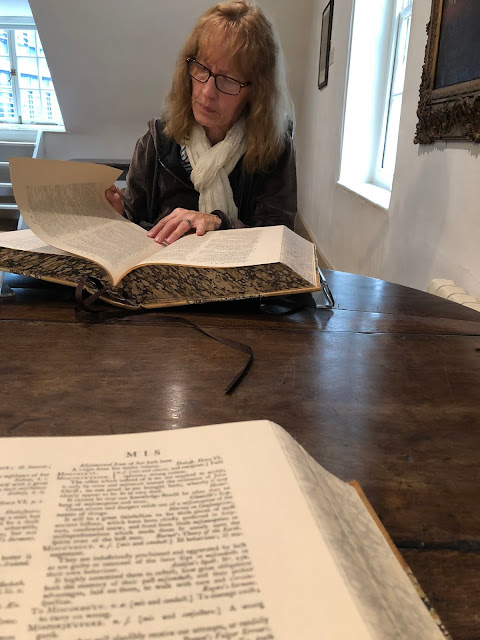Day two in London started out with coffee. That's always a good thing, indeed. We took the Underground to the Seven Dials area, and enjoyed a delicious coffee at Timberyard, a hip coffee shop that welcomes those who linger with laptops and journals. It was a great spot, and a delicious cappuccino. We would have lingered longer, but there was more to see that day.
On our way to Charing Cross Road bookshops, we passed the Agatha Christie memorial. I am an admirer of her mystery novels, and it was really fun to see a memorial to her in the center of London. Also, I get excited whenever there is a memorial dedicated to a great author.
We spent time in three bookshops all along Charing Cross Road, and passed lovely pubs and shops along the way. I wanted the day to be more relaxed and exploring neighbourhoods I had not explored before. We walked slowly, enjoying all the fun details of history that are all over London. One of the best things about London is that there is some history/story or detail on every block that is worth paying attention to. Like the saddler and harness maker verbiage from 1847 still on the brick building in Seven Dials. The Seven Dials name, by the way, comes from the little roundabout that has seven exits (streets) that branch off it. So many pubs (the majority of them) all have flowers adorning their facades. It's so pretty. I also discovered where all the telephone booths like to hang out.
We wandered through the streets, grabbed some lunch at Pizza Express (it's always good), and then met my friend, Faith, at the Somerset House, a beautiful, huge house used mostly for art exhibits and galleries. We sat at coffee shop there, Fernandez & Wells, catching up and talking about life and London. I met up with her a couple times in Oxford back in March, and now she's graduated from Oxford, she lives in London.
The rest of the afternoon consisted of meandering strolls along The Strand. Visiting the first Twining's Tea Shop (the original location from 1706) was such a delight, sampling a few teas, and buying a few more. Seeing the Royal Courts of Justice (the domineering Gothic style buildings), Temple Church (a round building dating from 1185, as a Templar church).
Next, we toured Dr. Samuel Johnson's house, back in a quiet area behind Fleet Street. Dr. Johnson (1709-1784) was very influential writer, devout Anglican, and possibly most well known for writing the Dictionary of the English Language, published in 1755. Just imagine, when our United States Declaration of Independence was written (and other founding documents), this was the dictionary widely used. The house was a lovely 4-storey building, with lots of original pieces, a library (with some first edition dictionaries), and several dictionaries on the table to enjoy reading. I loved the original wooden floorboards, and I imagined Dr. Johnson pacing these very floors as he pondered words, writing dictionary entries. Many of the entries are quite humourous. Here are a few fun examples:
Backfriend, noun: A friend backwards; that is, an enemy in secret.
Dull, adjective: Not exhilarating; not delightful: as, to make dictionaries is dull work.
Lexicographer, noun: A writer of dictionaries; a harmless drudge, that busies himself in tracing the original, and detailing the signification of words.
Loo, noun: a game at cards.
Oats, noun: A Grain, which in England is generally given to horses, but in Scotland supports the people.
Sock, noun: Something put between the foot and shoe.
Trolmydames, noun: Of this word I know not the meaning.
After dinner at the Wellington Pub, we walked across the river Thames back over to Waterloo, which was thoroughly enjoyable as the sun was setting and the light was a soft grey with twinges of oranges and pinks. What a perfect way to end a wonderful day in London.
























No comments:
Post a Comment